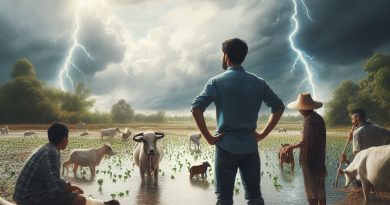Drought and Its Economic Impact on Farms
Last Updated on March 2, 2024
Introduction
Let’s explore Drought Economic Impact on Farms.
Drought poses significant economic challenges for farms worldwide.
Reduced water availability affects crop yields, livestock productivity, and overall profitability.
In this blog post, we’ll examine the economic repercussions of drought on farms, exploring how it impacts agricultural output, revenue streams, and operational costs.
Through real-world examples and data analysis, we’ll delve into the financial strain experienced by farmers during drought periods, including increased expenses for irrigation, feed, and supplementary water sources.
Additionally, we’ll discuss the broader economic ripple effects of drought on local communities, food prices, and global markets.
By shedding light on the economic dimensions of drought in agriculture, this post aims to raise awareness about the need for proactive drought management strategies and policies to support farmers and safeguard food security.
Effects of Drought on Agricultural Production
Drought has significant economic implications for farms, hampering agricultural production and affecting both crops and livestock.
In this section, we will explore the various effects of drought on farming.
Decreased crop yields
During droughts, water becomes limited, depriving plants of the necessary moisture for their growth and development.
This scarcity leads to stunted growth and reduces the overall yield of crops.
In the absence of sufficient water, photosynthesis is hindered, preventing plants from producing enough energy for their metabolic processes.
Additionally, the lack of water hampers the roots’ ability to absorb essential nutrients, further compromising crop yields.
Livestock management challenges
Drought conditions often deplete water sources such as rivers, lakes, and ponds, making it difficult for farmers to provide adequate hydration to their livestock.
Limited access to water puts the animals at risk of dehydration and affects their overall health and productivity.
Droughts lead to the deterioration of grazing lands, making it challenging for livestock to find sufficient food.
The scarcity of nutritious pasture forces farmers to rely on hay and feed supplements, increasing the costs of livestock management.
Increased susceptibility to pests and diseases
Drought weakens both crops and livestock, making them more susceptible to infestations and diseases.
Stressed plants are more attractive to pests, and weakened livestock are more prone to illnesses, resulting in decreased quality and quantity of agricultural products.
With weakened defenses, crops and livestock become highly vulnerable to substantial losses during droughts.
Pests and diseases can cause significant damage, affecting the economic viability of farms and leading to financial hardships for farmers.
In general, droughts present numerous challenges to agricultural production.
The scarcity of water disrupts plant growth, reduces crop yields, and increases livestock management difficulties.
Additionally, weakened crops and livestock become more prone to attacks from pests and diseases, exacerbating the economic impact on farmers.
It is crucial for the agricultural sector to develop effective strategies and sustainable water management practices to mitigate the adverse effects of drought on farms.
Read: Climate-Smart Farming: A Global Overview
Financial Consequences for Farmers
Loss of income
During droughts, farmers face several financial challenges that have a direct impact on their income and ability to sustain their businesses.
The loss of income is one of the primary consequences experienced by farmers during droughts.
As the availability of water decreases, crops and livestock suffer, leading to a decline in sales.
This directly affects the revenue generated by farmers and their ability to make a profit from their farming operations.
The reduction in profitability of farming operations is another significant consequence of drought.
With the scarcity of water and adverse weather conditions, farmers struggle to grow healthy crops and raise livestock.
This lowers the quantity and quality of produce, making it difficult to meet market demands and maintain profitability.
Higher production costs
In addition to the loss of income, farmers also face higher production costs during droughts.
The limited water supply prompts farmers to invest more in irrigation systems to keep their crops alive.
This leads to increased expenses and greater financial strain on farmers.
Furthermore, the rising prices of feed and forage add to the financial burden, as farmers have to spend more to provide adequate nutrition for their livestock.
Dependence on government assistance
To cope with the financial challenges posed by drought, farmers often seek government assistance.
They apply for drought relief programs that provide financial support and resources to help them sustain their operations during difficult times.
These programs are designed to alleviate the economic burden faced by farmers and help them recover from the impact of drought.
Apart from government assistance, farmers also become increasingly reliant on subsidies and loans to overcome the financial consequences of drought.
Subsidies help offset some of the production costs, making it more feasible for farmers to continue their operations.
Loans, on the other hand, provide farmers with additional capital to invest in their farms and meet their financial obligations.
Basically, drought has severe economic consequences for farmers.
The loss of income, higher production costs, and dependence on government assistance are some of the financial challenges that farmers face during droughts.
These factors not only impact the profitability of farming operations but also highlight the need for support systems and relief programs to mitigate the economic impact on farmers and help them sustain their livelihoods.
Read: Livestock Farming: Adapting to Climate Shifts

Impacts on Local and National Economy
Decrease in agricultural output
Drought has significant economic consequences, affecting both local communities and the entire nation.
With diminished agricultural output, farms contribute less to the country’s Gross Domestic Product (GDP) resulting in a decline in economic growth.
Moreover, the reduced food production caused by drought forces the nation to rely heavily on imported food for its supply, further straining the economy.
Effects on related industries
The impact of drought extends beyond the agricultural sector, affecting related industries as well.
With farms producing less, there is a decreased demand for farming machinery and equipment.
As a result, manufacturers and suppliers of these goods experience a decline in sales and revenue.
This, in turn, leads to job losses in farming support sectors such as manufacturing, transportation, and retail, which rely on the agricultural industry for their livelihood.
Ripple effects on rural communities
Not only do these economic consequences affect individual industries, but they also have a ripple effect on rural communities.
As farms experience a decrease in revenue, local spending and economic activity decline as well.
The entire community suffers the consequences, with businesses struggling to survive due to reduced customer demand.
This downturn in economic activity affects various sectors, such as restaurants, shops, and service providers, amplifying the negative impact of drought on the local economy.
Furthermore, the long-term effects of drought on farming communities can lead to potential migration or relocation of farmers.
Facing repeated crop failures and financial losses, farmers may choose to move to regions with more favorable climatic conditions and irrigation facilities.
This migration not only disrupts established communities but also poses challenges to the labor force and local population dynamics.
Lastly, drought has far-reaching economic implications on both local and national levels.
The decrease in agricultural output reduces farms’ contribution to the GDP and increases dependency on imported food.
This, in turn, affects related industries, leading to job losses and decreased economic activity in farming support sectors.
Additionally, the impacts extend to rural communities, with reduced local spending and potential migration or relocation of farmers.
Addressing these economic challenges requires proactive measures to mitigate the effects of drought and support affected industries and communities.
Read: Climate-Proof Crops: The Genetic Engineering Angle
Find Out More: Diverse Crops: Farming’s Answer to Climate?
Adaptation and Mitigation Strategies
Investing in Sustainable Water Management
Drought and its economic impact on farms necessitate the implementation of various adaptation and mitigation strategies.
By investing in sustainable water management practices, farmers can significantly reduce the adverse effects of water scarcity.
One approach is the adoption of efficient irrigation technologies that optimize water usage.
These technologies, such as drip irrigation or precision sprinklers, deliver water directly to plant roots, minimizing wastage through evaporation.
Additionally, rainwater harvesting and storage systems can be employed to utilize rainwater effectively during periods of drought.
By capturing and storing rainwater, farmers can ensure a more reliable water supply for their crops.
This approach is particularly crucial in regions where rainfall patterns are unpredictable or sporadic.
Crop Selection and Diversification
Crop selection and diversification also play a vital role in mitigating the economic impact of drought on farms.
Farmers should choose crop varieties that are more resilient to drought conditions.
These drought-resistant varieties have adaptations that allow them to thrive with limited water availability, reducing yield losses.
Diversifying crops to include those suitable for arid conditions can further optimize agricultural production.
Growing alternative crops, such as drought-tolerant grains or medicinal herbs, not only expands income sources but also makes farms more resilient to water scarcity.
Risk Management Approaches
Implementing risk management approaches is another essential aspect of adapting to drought.
Farmers can secure insurance coverage against crop and livestock losses caused by drought-induced damages.
This financial safety net provides economic stability and reduces the risk of bankruptcy.
Diversifying income sources is also crucial in risk management.
Farmers can explore agrotourism initiatives, such as farm stays or agritourism activities, to generate additional revenue.
Additionally, producing value-added products, like artisanal jams or organic skincare, can increase farm profitability and lessen dependence on traditional crop yields.
Overall, combating the economic impact of drought on farms requires a multi-faceted approach.
Investing in sustainable water management practices, including efficient irrigation technologies and rainwater harvesting systems, can mitigate water scarcity.
Crop selection and diversification, with a focus on drought-resistant varieties and alternative crops, improve farmers’ resilience to drought-induced losses.
Risk management approaches, such as insurance coverage and income diversification, provide financial stability and reduce vulnerability.
By adopting these adaptation and mitigation strategies, farmers can better navigate the challenges posed by drought and safeguard their economic viability.
Read: Carbon Farming: Agriculture’s Climate Promise
Conclusion
Drought poses significant economic challenges for farms, impacting crop yields, livestock production, and overall profitability.
Farmers must adopt resilient strategies to mitigate the adverse effects of drought, such as implementing water-saving technologies and diversifying crops.
Government support and risk management tools are crucial in assisting farmers during periods of drought.
Investments in research and innovation can lead to the development of drought-resistant crop varieties and sustainable farming practices.
Collaboration among stakeholders, including farmers, policymakers, and scientists, is essential in addressing the complex challenges posed by drought.
By taking proactive measures and fostering resilience, farms can better withstand the economic impacts of drought and ensure the long-term sustainability of agriculture.


